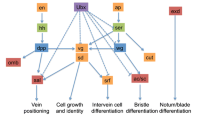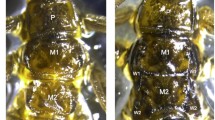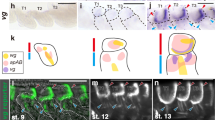Abstract
The neurogenesis and neuronal functions in insect wing have been understudied mainly due to technical hindrances that have prevented electrophysiology studies for decades. The reason is that the nano-architecture of the wing chemosensory bristles hampers the receptors accessibility of odorants/tastants to receptors in fixed setup, whereas in nature, the wing flapping mixes these molecules in bristle lymph. In this report, we analyzed the transcriptome of the wing tissue of two species phylogenetically strongly divergent: Drosophila melanogaster a generic model for diptera order (complete metamorphosis) and the aphid acyrthosiphon pisum, representative of hemiptera order (incomplete metamorphosis) for which a conditional winged/wingless polyphenism is under control of population density and resources. The transcriptome shows that extensive gene networks involved in chemosensory perception are active in adult wing for both species. Surprisingly, the specific transcripts of genes that are commonly found in eye were present in Drosophila wing but not in aphid. The analysis reveals that in the aphid conditional wing, expressed genes show strong similarities with those in the gut epithelia. This suggests that the epithelial cell layer between the cuticle sheets is persistent at least in young aphid adult, whereas it disappears after emergence in Drosophila. Despite marked differences between the two transcriptomes, the results highlight the probable universalism of wing chemosensory function in the holometabolous and hemimetabolous orders of winged insects.










Similar content being viewed by others
References
Ashkenas J, Muschler J, Mina J, Bissell MJ (1996). The extracellular matrix in epithelial biology: shared molecules and common themes in distant phyla. Dev Biol 180:433–444
Belalcazar AD, Doyle K, Hogan J, Neff D, Collier S (2013) Insect wing membrane topography is determined by the dorsal wing epithelium. G3 (Bethesda) 3:5–8
Benton R, Vannice KS, Gomez-Diaz C, Vosshall LB (2009) Variant ionotropic glutamate receptors as chemosensory receptors in Drosophila. Cell 136:149–162
Braendle C, Davis GK, Brisson JA, Stern DL (2006) Wing dimorphism in aphids. Heredity 97:192–199
Brisson JA, Stern DC (2006) The pea aphid Acyrthosiphon pisum: an emerging genome model system for ecological developmental evolutionary studies. Biossays, 28:747–755
Brisson JA, Davis GK, Stern DL (2007) Common genome-wide patterns of transcript accumulation underlying the wing polyphenism and polymorphism in the pea aphid. Evol Dev 9:338–346
Cameron P, Hiroi M, Ngai J, Scott K 2010. The molecular basis for water taste in Drosophila. Nature, 465:91–95
Cho EH, Nijhout HF (2013) Development of polyploidy of scale-building cells in the wings of Manduca sexta. Arthropod Struct Dev 42:37–46
Clyne PJ, Warr CG, Carlson JR (2000) Candidate taste receptors in Drosophila. Science 287:1830–1834
Dickinson M (2006) Insect flight. Curr Biol 16:R309-14
Dickinson MH, Lehmann FO, Sane SP (1999) Wing rotation and the aerodynamic basis of insect flight. Science 284:1954–1960
Dixon A.F.G. (1998) Aphid Ecology. Chapman & Hall, London
Hartenstein V, Posakony JW (1989) Development of adult sensilla on the wing and notum of Drosophila melanogaster. Development 107:389–405
Hkmat-Scafe DS, Scafe CR, Mckinney AJ, Tanouye MA (2002) Genome-wide analysis of the odorant-binding protein gene family in Drosophila melanogaster. Genome Res 12:1357–1369
Johnson SA, Milner MJ (1987) The final stages of wing development in Drosophila melanogaster. Tissue Cell 19:505–513
Kiger JA, Natzle JE, Kimbrell DA, Paddy MR, Kleinhesselink K, Green MM (2007) Tissue remodeling during maturation of the Drosophila wing. Dev Biol 301:178–191
Kimura KI, Kodama A, Hayasaka Y, Takumi Ohta T (2004) Activation of the cAMP/PKA signaling pathway is required for postecdysial cell death in wing epidermal cells of Drosophila melanogaster. Development 131:1597–1606
Labandeira C, Phillips T (1996) A carboniferous insect gall: insight into the early ecological history of the Holometabola. Proc Natl Acad Sci USA 93:8470–8474
Misof B et al (2014) Phylogenomics resolves the timing and pattern of insect evolution. Science 346:763–767
Ogawa K, Miura T (2013) Two developmental switch points for the wing polymorphisms in the pea aphid Acyrthosiphon pisum. Evol Dev 4:30
Peters RS et al (2014) The evolutionary history of holometabolous insects inferred from transcriptome-based phylogeny and comprehensive morphological data. BMC Evol Biol 14:52
Raad H, Ferveur JF, Ledger N, Capovilla M, Robichon A (2016) Functional gustatory role of chemoreceptors in Drosophila Wings. Cell Rep 15:1442–1454
Reynolds SE (1977) Control of cuticle extensibility in the wings of adult Manduca at the time of eclosion: effects of eclosion hormone and bursicon. J Exp Biol 70:27–30
Scott K et al (2001) Chemosensory gene family encoding candidate gustatory and olfactory receptors in Drosophila. Cell 104:661–673
Seligman IM, Doy FA, Crossley AC (1975) Hormonal control of morphogenetic cell death of the wing hypodermis in Lucilia cuprina. Tissue Cell 7:281–296
Smadja C. Shi P, Butlin RK, Hugh M, Robertson HM (2009) Large gene family expansions and adaptive evolution for odorant and gustatory receptors in the pea aphid, Acyrthosiphon pisum. Mol Biol Evol 26:2073–2086
Starostina E, Xu A, Lin H, Pikielny CW (2009) A Drosophila protein family implicated in pheromone perception is related to Tay-Sachs GM2-activator protein. J Biol Chem 284:585–594
Stocker RF (1994) The organization of the chemosensory system in Drosophila melanogaster: a review. Cell Tissue Res 275:3–26
Valmalette JC, Raad H, Qiu N, Ohara S, Capovilla M, Robichon A (2015) Nano architecture of gustatory chemosensory bristles and trachea in Drosophila wings. Sci Rep 5:14198
Vieira FG, Rozas J (2011) Comparative genomics of the odorant-binding and chemosensory protein gene families across the Arthropoda: origin and evolutionary history of the chemosensory system. Genome Biol Evol 3:476–490
Vosshall LB, Stocker RF (2007) Molecular architecture of smell and taste in Drosophila. Annu Rev Neurosci 30:505–533
Acknowledgements
We are very grateful to Jean François Ferveur for fruitful discussions. The Drosophila Bloomington Stock Center is acknowledged for fly stocks. We thank a lot Aviv Dombrovsky and Jean Christophe Valmalette that gave rise to this manuscript, inspired by an initial work brought together. This work was supported by the ANR “blanc,” acronym: “Gustaile,” and the ANR “blanc,” acronym “methylclonome,” and by the French Government (National Research Agency, ANR) through the LABEX SIGNALIFE program (reference # ANR-11-LABX-0028-01).
Author information
Authors and Affiliations
Corresponding author
Electronic Supplementary Material
Below is the link to the electronic supplementary material.
Rights and permissions
About this article
Cite this article
Agnel, S., da Rocha, M. & Robichon, A. Transcriptome Profiling of Neurosensory Perception Genes in Wing Tissue of Two Evolutionary Distant Insect Orders: Diptera (Drosophila melanogaster) and Hemiptera (Acyrthosiphon pisum). J Mol Evol 85, 234–245 (2017). https://doi.org/10.1007/s00239-017-9814-8
Received:
Accepted:
Published:
Issue Date:
DOI: https://doi.org/10.1007/s00239-017-9814-8




